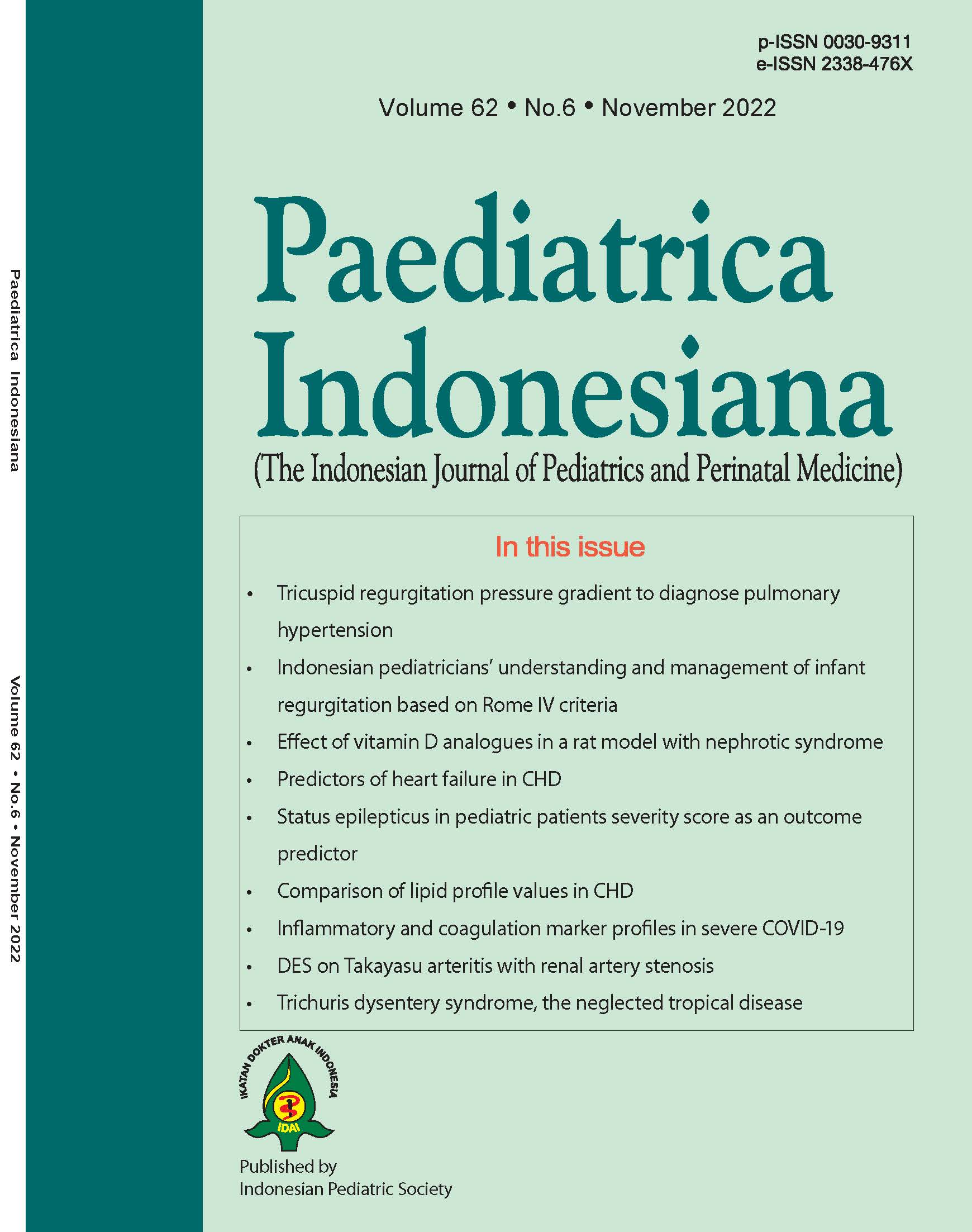Trichuris dysentery syndrome, the neglected tropical disease: a case series
Abstract
Almost 2 billion people, about a quarter of the world’s population, are infected with soil-transmitted helminths (STH) worldwide. Approximately 270 million preschool children and more than 550 million school-age children live in areas of extensive parasite transmission.1,2 Indonesia is a moderate-to-high-risk area of STH, with an overall mean prevalence of 28.12%. However, the prevalence in Papua is higher.3 A study reported that 50% of school-aged children in Jayapura, Papua, a high-risk area, suffered from STH, with distributions of 48.5% Ascaris lumbricoides, 28.6% Trichuris trichiura, 14.3% hookworm, and 8.6% mixed infection.4
References
2. Schulz JD, Moser W, Hürlimann E, Keiser J. Preventive chemotherapy in the fight against soil-transmitted helminthiasis: achievements and limitations. Trends Parasitol. 2018;34:590–602. DOI: 10.1016/j.pt.2018.04.008.
3. Badan Litbangkes Kemenkes RI. Laporan Nasional RISKESDAS 2017. Jakarta: Kemenkes RI; 2017.
4. Martila M, Sandy S, Paembonan N. Hubungan higiene perorangan dengan kejadian kecacingan pada murid SD Negeri Abe Pantai Jayapura. J Plasma. 2016;1:87–96. DOI : 10.22435/plasma.v1i2.4538.87-96.
5. Kaminsky RG, Castillo RV, Flores CA. Growth retardation and severe anemia in children with Trichuris dysenteric syndrome. Asian Pac J Trop Biomed. 2015;5:591–7. DOI: 10.1016/j.apjtb.2015.05.005.
6. Noorizan AM, Raj SM. Trichuris dysentery syndrome?: evidence that it may be underdiagnosed in Kelantan. Med J Malaysia. 2001;56:53–7. PMID: 11503297.
7. Khuroo MS, Khuroo MS, Khuroo NS. Trichuris dysentery syndrome?: a common cause of chronic iron deficiency anemia in adults in an endemic area (with videos). Gastrointest Endosc. 2010;71:200–4. DOI: 10.1016/j.gie.2009.08.002.
8. Brooker SJ. Soil-transmitted helminth treatment: multiple drug regimens. Lancet Infect Dis. 2018;18:698–9. DOI: 10.1016/S1473-3099(18)30268-8.
9. WHO Working group on Soil-transmitted helminthiasis. Monitoring anthelmintic efficacy for soil transmitted helminths (STH). 2008. (cited 2020 February 20) Available from: https://www.who.int/docs/default-source/ntds/soil-transmitted-helminthiases/monitoring-anthelmintic-efficacy-for-sth-march-2008.pdf.
10. Agarwal A. Pica- an enigma of malnutrition. J Nutr Disord Ther. 2017;07:7–8. DOI: 10.4172/2161-0509.1000e132.
11. WHO. WHO Global Nutrition Targets 2025: Stunting Policy Brief [Internet]. Genewa, Swiss; 2014 [cited 2019 Jun 27]. Available from: https://www.who.int/nutrition/topics/globaltargets_stunting_policybrief.pdf
12. Anto EJ, Nugraha SE. Efficacy of albendazole and mebendazole with or without levamisole for ascariasis and trichuriasis. Open Access Maced J Med Sci. 2019;7:1299–302. DOI: 10.3889/oamjms.2019.299.
13. Knopp S, Mohammed KA, Speich B, Hattendorf J, Khamis IS, Khamis AN, et al. Albendazole and mebendazole administered alone or in combination with ivermectin against Trichuris trichiura: a randomized controlled trial. Clin Infect Dis. 2010;51:1420–8. DOI: 10.1086/657310.
Copyright (c) 2022 Yulia Fatma Wardani, Sp.A, M.Sc, Ida Safitri Laksono, DR. SpA(K), Teti Adriana Lubis, Sp.A, M.Sc

This work is licensed under a Creative Commons Attribution-NonCommercial-ShareAlike 4.0 International License.
Authors who publish with this journal agree to the following terms:
Authors retain copyright and grant the journal right of first publication with the work simultaneously licensed under a Creative Commons Attribution License that allows others to share the work with an acknowledgement of the work's authorship and initial publication in this journal.
Authors are able to enter into separate, additional contractual arrangements for the non-exclusive distribution of the journal's published version of the work (e.g., post it to an institutional repository or publish it in a book), with an acknowledgement of its initial publication in this journal.
Accepted 2022-10-11
Published 2022-10-11













